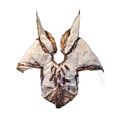
Find information about
Paula Santiago's bio, signature and artwork
at 32 Reales
Do you have art to appraise or sell?
Get an appraisal or sell art by Paula Santiago by filling out this form
Paula Santiago
(1969)
"Without ostentation Paula Santiago offers her own blood, her sustaining magic, not to feed the Sun or the Earth, but to convince herself through sacrifice that life exists"
- Raquel Tibol
Born and based in Guadalajara, Mexico, she is an artist whose creative journey has been as haunting as it is fascinating. Her artistic career began at the intersection of frustration and the constant search for expression. Though her path was hampered by several false starts, she would eventually find her own unique voice in a process that embraced authenticity, transformation, and femininity.
After exploring fields such as Industrial Design and painting, Santiago left her studies in Mexico behind to embark on a journey that would change her course. Paris and London became her classroom, where she studied literature and art history at the Sorbonne. It was in London where her life became intertwined with that of the Nicaraguan artist Armando Morales, in whose studio she worked, absorbing influences and learning techniques.
A turning point in Santiago's career occurred in 1996, when she received a grant from the ArtPace Foundation for Contemporary Art in San Antonio, Texas. This opportunity marked a turning point in her artistic approach to her, taking her back to the materials she had seen her relatives use during her childhood. Needle and thread replaced brush and canvas, and her experimentation with textiles began to define her mature work.
Her first solo show at Galería Iturralde featured a collection of garments embroidered and stained with a substance that would come to define and redefine her work: blood. From her time in Texas and for many years after her, Santiago harvested her own blood to stain the surface of her rice paper drawings. Often, she would embroider the paper, substituting human hair for traditional embroidery thread. The emotional impact of these visceral materials is undeniable.
However, years of harvesting her own blood came to an abrupt end when she was diagnosed with skin cancer. The disease caused a great change in the materials and emotions of her work. Instead of darkness and absence, healing and mending became apparent. The drawings previously stained with Santiago's blood were reworked, covering the stained surfaces with a translucent wax that protected without hiding the underlying materials. Many of these works were shredded and reassembled into the partially woven, wax-covered forms that were exhibited in her second solo show, "Septum."
Strappy weaves are combined with organic shapes that evoke bones and internal cavities, suggesting but not quite resembling figurative human forms. Much of her work in "Septum", like the one that precedes it, dialogues with the theoretical concepts developed by French Feminism in the last three decades. Starting from the physical body, French Feminism conceives of the female body as a "permeable container", a notion captured in Luce Irigaray's concept of the "placental economy". The intentional harvesting and subsequent coating of bodily fluids by Santiago creates a system of exchange, give and take, as in the exchange of fluids between mother and child.
The notion of an unspecified limit that cannot or does not work in only one way is reflected in Santiago's wax-covered forms. Emerging first from the fluid stains demanded by her previous work, these transformations embody an exchange. While the wax protects fluid stains, it makes no effort to hide its presence, instead acting as a protective layer of skin that draws attention to substances below the surface.
The process of dividing the rice paper into strips and weaving them together buries the stains in the fabric of the new work. The amalgamation of these products and the additional wax-covered forms bring the viewer closer to the corporeal and, ultimately, to the elusive meaning behind Santiago's bone-like forms and orifices. In addition, the passages woven into these works echo the earlier tradition of embroidery that Santiago turned to in search of her own expression. She has managed to create a "placental economy" between the familiar processes of sewing and knitting and the unknown world that the artist and these works now inhabit.
In the words of Irigaray: "One would have to listen with another ear, as if one were listening to an 'other meaning' always in the process of weaving itself, of embracing oneself with words, but also of detaching oneself from words so as not to remain fixed, frozen in them. ". The constant flux between the familiar and the unknown is the new world from which Santiago speaks.
The act of picking up a needle and thread may be embedded in the subconscious, conditioned by the millennia in which men and women have found personal and productive expression through thread and cloth. In celebrating this fact, Santiago has come to her own conclusions and now speaks with a voice undeniably her own. Her art goes beyond convention, defying barriers and exploring the inner corners of femininity and transformation. With each of her works, Paula Santiago weaves a legacy of artistic daring and female empowerment that will live on in art history.
